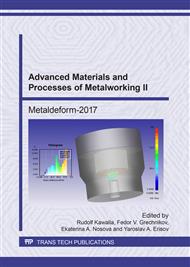p.22
p.29
p.36
p.48
p.56
p.63
p.69
p.75
p.84
The Research of Friction Influences on the Formation Process by Lateral Extrusion into Radial Wedge-Type Branches
Abstract:
The article represents theoretical analysis of friction influence on the process of formation experimental blank with several radial wedge-type branches having different constituent convergence angles. The authors show that with the correlation between volumes of material what are extruded into the branches it is possible to define the friction coefficient for set conditions of forging. Such approach allows suggesting the methodology for exact definition of friction coefficient for forged blank with a large area of contact surface. For the analysis the analytical model is used which was obtained by upper-bound approach technique. Calibration measurement of accuracy of a model was carried out by numerical method in Deform 3D.
Info:
Periodical:
Pages:
56-62
Citation:
Online since:
July 2017
Price:
Сopyright:
© 2017 Trans Tech Publications Ltd. All Rights Reserved
Share:
Citation:


